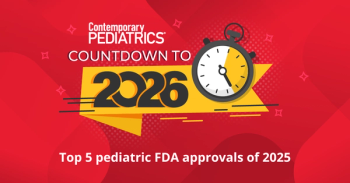
An 11-year-old boy with a petechial rash: A peculiar presentation
His vital signs in clinic were within normal limits, and the only additional finding at this time was a nontender, nonpruritic, and nonpalpable petechial rash on the bilateral lower extremities.
The case:
In November 2023, an otherwise healthy 11-year-old boy presented to the clinic with the chief concern of testicular discomfort. He reported mild testicular pain that worsened with physical activity, and he denied the presence of dysuria, urinary urgency, or frequency. He was recently evaluated by an ear, nose, and throat specialist for an episode of epistaxis, which was benign and resolved without requiring cauterization. His medical history was otherwise unremarkable, notable only for molluscum contagiosum at the age of 5 years and a few episodes of streptococcal pharyngitis and otitis media.
His vital signs in clinic were within normal limits, and the only additional finding at this time was a nontender, nonpruritic, and nonpalpable petechial rash on the bilateral lower extremities. His mother observed that the rash appeared to fluctuate with his activity level, worsening during periods of increased stress or activity.
Given the presence of petechiae, an initial workup was initiated, including a complete blood count, comprehensive metabolic panel, prothrombin time, and partial thromboplastin time. A point-of-care urinalysis performed in the clinic revealed traces of blood in the urine. The patient appeared well and did not show any other signs of illness. He was diagnosed with viral epididymitis pending laboratory results. He was advised to remain hydrated and to return for follow-up if his symptoms persisted or worsened. His mother agreed with this plan and committed to closely monitoring his rash.
Over the following week, he returned to our clinic. His rash had progressed, spreading to his thighs, buttocks, and the distal shaft of his penis. All his previous laboratory test results were within normal limits, and additional workup was initiated, including a platelet function assay and measurements of serum IgA, C3, and C4 levels along with a repeat urinalysis.
Given our differential at this time, the patient was referred to pediatric hematology. When seen by hematology, the boy reported shortness of breath while playing baseball, which was unusual for him. His physical examination results revealed a nonblanchable, nonpruritic petechial rash. Trace blood was seen again in his urinalysis. Concern increased for small-vessel vasculitis with involvement of the lung and kidney, and further referrals to rheumatology and dermatology were made.
Final diagnosis
Given the uncertainty of his diagnosis, the dermatology performed 2 punch biopsies of the left leg, which revealed leukocytoclastic vasculitis with IgA and C3 deposition—findings that align with IgA vasculitis. Rheumatology and nephrology monitored for systemic involvement and reported no parenchymal lung disease or significant proteinuria. He was also seen by pulmonology for his shortness of breath.
With a diagnosis of IgA vasculitis, he was treated with low-dose prednisone and later switched to dapsone, with an excellent response. His primary care provider continued to follow him for routine urinalyses, results of which remained stable over time. With no additional abnormal findings, he did not require a kidney biopsy to further evaluate his disease. The rash resolved, and he has since remained symptom free.
Discussion
IgA vasculitis, formerly known as Henoch-Schönlein purpura, is the most common vasculitis in children.1 Globally, 90% of cases occur between the ages of 2 and 10 years, with a peak incidence between the ages of 4 and 7 years.2 The diagnosis requires palpable purpura and 2 conditions of the following: arthritis, kidney disease, or abdominal pain. If the patient has a classic presentation with these symptoms, IgA vasculitis is straightforward to diagnose in a clinical setting. With other manifestations of the disease and unusual symptoms, the diagnosis of IgA vasculitis can become rather challenging.
In complex cases, such as this 11-year-old boy with atypical symptoms, a skin biopsy can be performed to sample superficial small blood vessels for diagnosis.3 Kidney biopsies are reserved for patients with equivocal findings from skin biopsy or concerns of prominent kidney disease.
In IgA vasculitis, IgA immune complexes deposit in small blood vessels, producing a characteristic rash. The rash is classically nonpruritic and begins with erythematous papules or urticarial wheals before maturing into crops of purpura.4 In the case discussed above, the patient presented with a petechial rash, which is not consistent with the characteristic purpura associated with IgA vasculitis.
Immune complex deposition in small vessels can lead to the involvement of many organ systems. For instance, abdominal pain may result from immune complex deposition in the small vessels of the intestinal wall. Kidney involvement ranges from mild proliferative to severe crescentic glomerulonephritis.4 Urologic involvement may also occur, which classically presents with pain, tenderness, and swelling of the involved testicle and/or scrotum.5 Lung findings typically include mild interstitial changes and impaired lung diffusion capacity. Other manifestations of disease include migratory oligoarticular arthritis, keratitis or uveitis, and seizures or encephalopathy. In the case discussed, the patient presented with urological symptoms and microscopic hematuria, with additional concern for lung involvement.
IgA vasculitis is more commonly seen in children than in adults, as it is strongly associated with childhood viral and bacterial infections. Specifically, Streptococcus, parainfluenza, and human parvovirus B19 are associated with the cytokines and chemokines that cause IgA vasculitis, but the exact pathophysiology is not well understood.4 After the initial episode, recurrence is also possible. One study by Lei et al evaluated 1000 patients with IgA vasculitis, and results found a 16.2% recurrence rate, with varying time intervals between episodes.6 In the case discussed, the patient did not have any history of preceding infection. During routine follow-up, there were no concerns of recurrence after his symptoms resolved with glucocorticoid use.
There is no specific treatment for IgA vasculitis, and symptomatic management is indicated for refractory cases. Red blood cell transfusions may be required for significant anemia. If a patient presents with abdominal pain with signs of obstruction or peritonitis, an abdominal ultrasound with surgical consultation should be performed for possible intussusception, a possible complication of IgA vasculitis.7 Most other symptoms, including arthralgias, orchitis, skin rashes, cerebral vasculitis, or mild nephritis, are treated with glucocorticoids.8 Acetaminophen or nonsteroidal anti-inflammatory drugs may be used to treat abdominal or joint pain. Refractory rashes or severe kidney impairment are indications for further pharmacologic management with colchicine, dapsone, rituximab, or other such agents requiring extra precautions for each individual patient.9
Follow-up visits should be scheduled weekly for the first month, biweekly for the second month, monthly for the next 6 months, and then every 3 months for another 6 months.11 Although most patients achieve remission in 4 weeks, follow-up is crucial for monitoring kidney function and preventing kidney disease, which can be a late finding.
Lesson learned
IgA vasculitis presents a constellation of symptoms that can be difficult to diagnose over a prolonged clinical course. This report highlights the evolving symptomatology in IgA vasculitis, emphasizing the importance of the characteristic petechiae of this syndrome. Recognizing different manifestations of the rash for IgA vasculitis, ranging from wheals to petechiae to purpuras, can be helpful in establishing an early diagnosis. With proper recognition and accurate diagnosis, clinicians can ensure targeted monitoring and effective management of IgA vasculitis.
References
- Szer IS. Henoch-Schönlein purpura. Curr Opin Rheumatol. 1994;6(1):25-31. doi:10.1097/00002281-199401000-00005
- Leung AKC, Barankin B, Leong KF. Henoch-Schönlein purpura in children: an updated review. Curr Pediatr Rev. 2020;16(4):265-276. doi:10.2174/1573396316666200508104708
- Jennette JC, Falk RJ. Small-vessel vasculitis. N Engl J Med. 1997;337(21):1512-1523. doi:10.1056/NEJM199711203372106
- Reamy BV, Servey JT, Williams PM. Henoch-Schönlein purpura (IgA vasculitis): rapid evidence review. Am Fam Physician. 2020;102(4):229-233.
- Dalpiaz A, Schwamb R, Miao Y, Gonka J, Walzter W, Khan SA. Urological manifestations of Henoch-Schonlein purpura: a review. Curr Urol. 2015;8(2):66-73. doi:10.1159/000365692
- Lei WT, Tsai PL, Chu SH, et al. Incidence and risk factors for recurrent Henoch-Schönlein purpura in children from a 16-year nationwide database. Pediatr Rheumatol Online J. 2018;16(1):25. doi:10.1186/s12969-018-0247-8
- Mu J. Clinical characteristics and risk factors of IgA vasculitis with intussusception and intestinal perforation. J Paediatr Child Health. 2024;60(1):5-11. doi:10.1111/jpc.16516
- Roache-Robinson P, Killeen RB, Hotwagner DT. IgA vasculitis (Henoch-Schönlein purpura). In: StatPearls. StatPearls Publishing; 2025.
- Williams CEC, Lamond M, Marro J, Chetwynd AJ, Oni L. A narrative review of potential drug treatments for nephritis in children with IgA vasculitis (HSP). Clin Rheumatol. 2023;42(12):3189-3200. doi:10.1007/s10067-023-06781-8
- Abu-Zaid MH, Salah S, Lotfy HM, et al. Consensus evidence-based recommendations for treat-to-target management of immunoglobulin A vasculitis. Ther Adv Musculoskelet Dis. 2021;13:1759720X211059610. doi:10.1177/1759720X211059610
Newsletter
Access practical, evidence-based guidance to support better care for our youngest patients. Join our email list for the latest clinical updates.








